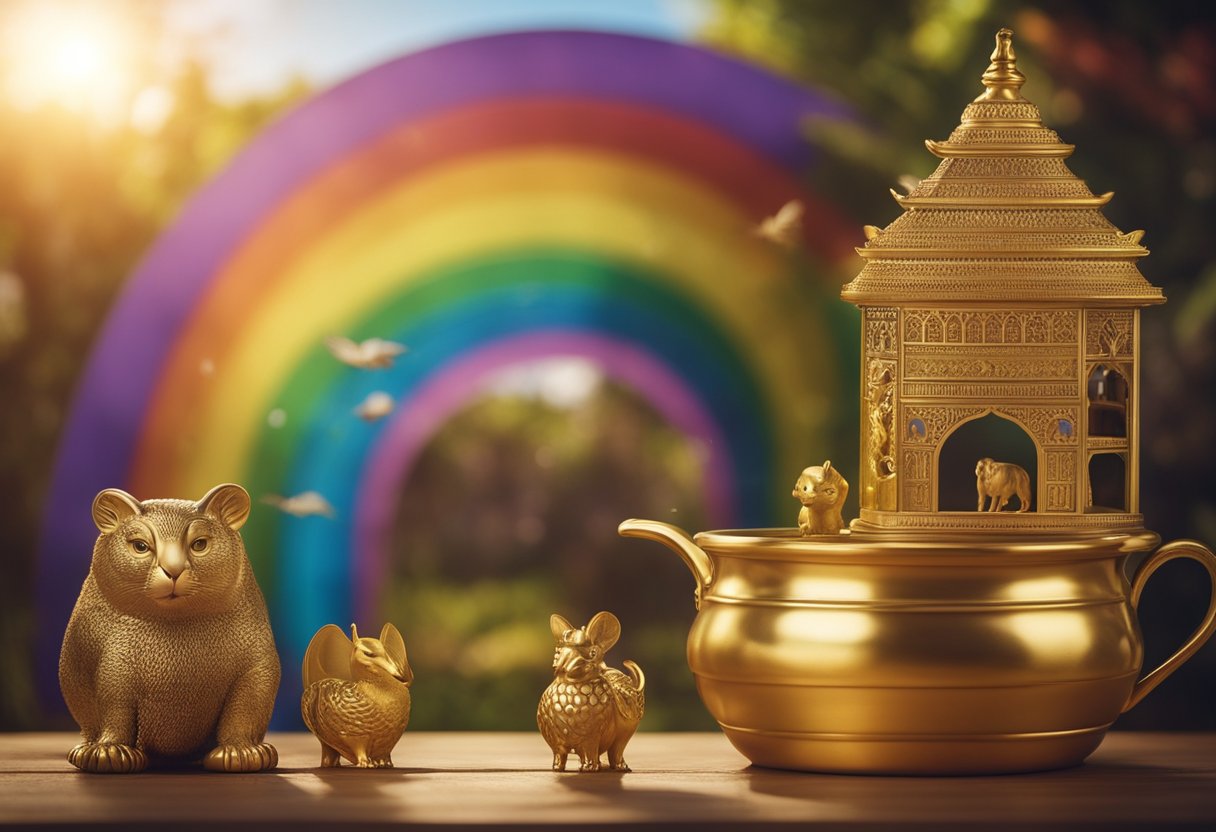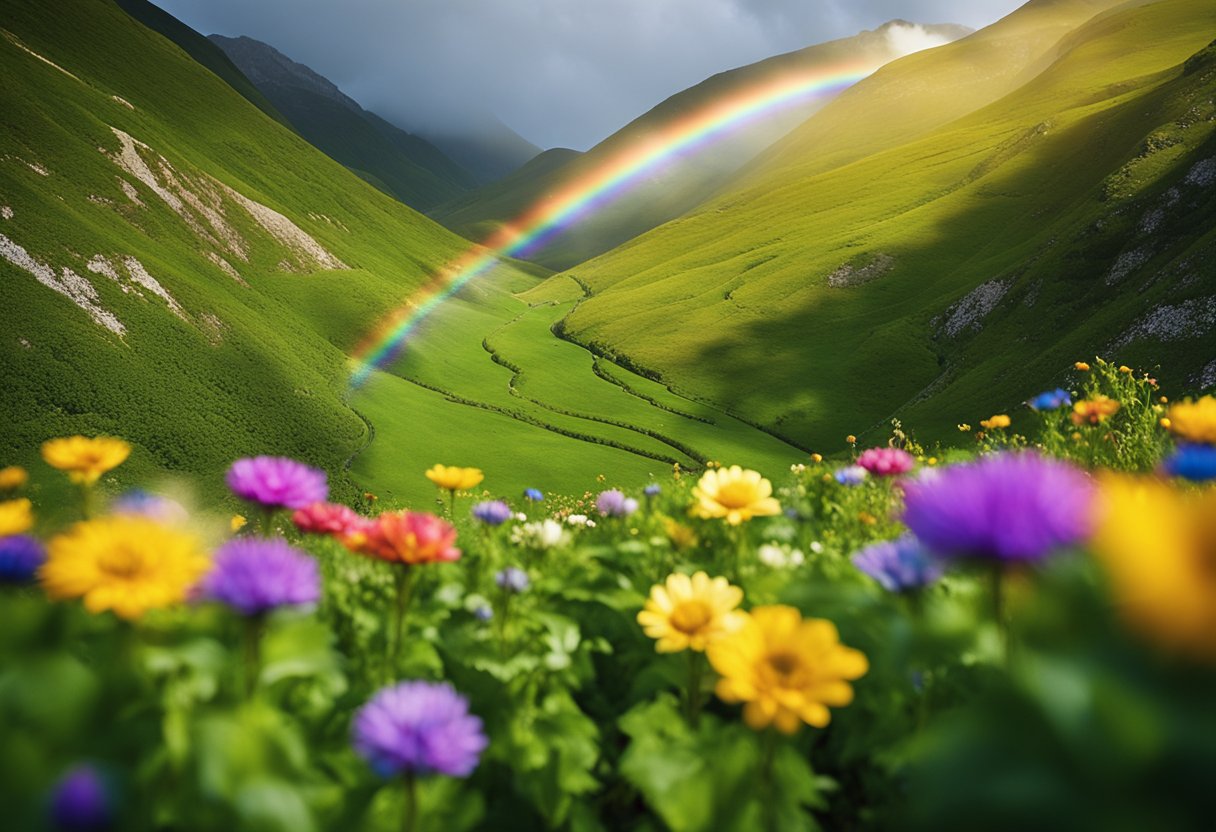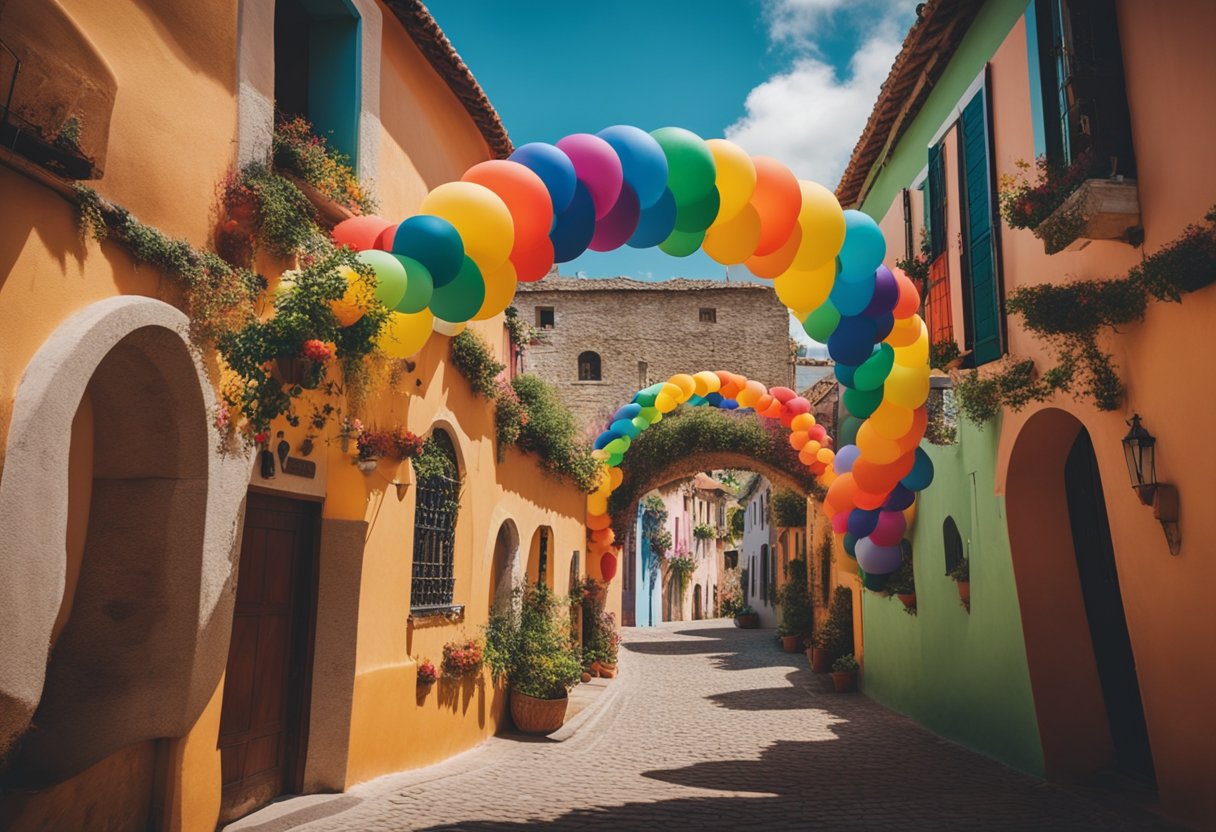International Tales of Rainbows and Pots of Gold: Explore Interesting Myths

Updated On: April 23, 2024 by Fatma Mohamed
Throughout the ages, the tales of Rainbows have captivated societies worldwide, embodying the intersection of nature’s beauty for storytelling. From the rolling green hills of Ireland, where tales of leprechauns concealing their pots of gold at the arc’s end prevail, to the varying interpretations that cultures around the globe attach to this natural spectacle, rainbows serve as a universal symbol bridging reality and myth.
Table of Contents

The allure of the pot of gold at the rainbow’s end is undeniably one of the most enduring tales, particularly in Irish folklore, where the mischievous leprechaun plays the role of guardian over this elusive treasure. This story, rooted in Irish tradition, reflects a broader human fascination with luck, fortune, and the pursuit of that which is just beyond reach. Beyond its mythical appeal, the rainbow has woven itself into the fabric of numerous cultures, serving as a reminder of life’s cyclical nature.
Our fascination with rainbows extends beyond their visual splendour, prompting us to explore their significance in cultural festivities, artistic expressions, and even moral teachings within stories. In this way, the luminous arc in the sky becomes more than a fleeting meteorological event; it is a canvas upon which generations of humans have painted tales of hope, fortune, and the everlasting dance of the natural world.
The Phenomenon of Rainbows

Rainbows are a natural spectacle, combining the elegance of physics with the splendour of bright, ephemeral colours in the sky. Understanding the science behind rainbows and their formation due to weather conditions helps us appreciate their symbolic significance across different cultures.
Science Behind Rainbows
Rainbows are created by the intricate interplay of light and water droplets. This process begins when sunlight is refracted upon entering a raindrop, splitting into its constituent colours. Each colour bends at a slightly different angle, with red bending the least and violet the most, causing a spectrum of colours to fan out. Known as dispersion, this spectrum is then reflected inside the raindrop before the light exits it, often undergoing a second refraction as it moves back into the air and ultimately reaches our eyes.
Symbolism of Colours
Each colour of the rainbow has often been attributed its own meaning and significance. For example, in Irish tradition, colours might be linked to attributes of nature or the divine. Around the world, red has been seen as a sign of strength and passion, orange as creativity and transformation, yellow as happiness and energy, green for growth and harmony, blue for tranquillity and health, indigo for intuition, and violet representing spiritual awareness and wisdom.
Weather and Rainbow Formation
The presence of a rainbow in the sky is tied closely to specific weather conditions. Rainbows generally form when the skies begin to clear after a rain shower, with the sun shining from behind the observer who is facing a damp, sunlit area. The sun’s rays enter the falling water droplets at a precise angle, typically 42 degrees relative to the observer’s line of sight, creating the optimal condition for a rainbow’s appearance. This beautiful interaction between light, water droplets, and our vision illustrates the complex dance between the science of meteorology and the perceptual magic of colours.
Legends of the Pot of Gold
In various cultures, tales of pots of gold symbolise fortune and the consequences of human desires. Here, we explore the myths that continue to capture imaginations worldwide.
Irish Folklore and Leprechauns
In Irish folklore, the leprechaun is a type of fairy known for his trickery and for guarding a pot of gold. These elusive creatures, often depicted in emerald green attire, embody the notion of good luck if caught. However, their cunning often allows them to evade capture. Stories suggest that leprechauns hide their pots of gold at the end of a rainbow, a place impossible to reach, teaching lessons on the futility of greed and the pursuit of unreachable wealth.
End of Tales of Rainbows
The myth of a pot of gold lying at the end of a rainbow spans various cultures and is often found in folklore. This reflects the human quest for riches and how it can be as elusive as finding the end of a rainbow itself—something that is scientifically impossible as rainbows are circular and don’t have an end.
The Role of Luck and Greed
Tales of the pot of gold frequently illustrate the balance between luck and greed. The heart of these stories often warns that even if one is lucky enough to find a leprechaun or its treasure, greed may lead to losing it. It’s a reminder of the old adage that not all that glitters is gold, and sometimes, the pursuit of material wealth can lead to one’s downfall.
Cultural Significance

Rainbows and pots of gold fascinate us due to their deep roots in folklore and their prevalent use in cultural festivities and mythologies across the globe. They evoke a sense of wonder, magic, and the possibility of finding treasure, connecting various cultures with shared tales of prosperity and luck.
St. Patrick’s Day Celebrations
The most renowned connection between pots of gold and celebrations can be found in Ireland on St. Patrick’s Day, where the legend of the leprechaun’s pot of gold symbolises the promise of luck and wealth. Parades and festivities across Ireland feature shamrocks, which are associated with the teachings of St. Patrick and the leprechaun from legends, adding a magical element to the celebrations.
Cross-Cultural Pot of Gold Stories
While Ireland may have popularised the pot of gold narrative, many cultures share stories where rainbows signify the presence of treasures. From Europe to Asia, legend speaks of magic and wealth to be found at the base of a rainbow, demonstrating the universal appeal of these tales of fortune.
Rainbows in Mythologies Globally
Globally, rainbows have held a significant place in various mythologies, representing bridges to the divine, messages from the gods, and symbols of hope and promise. The Norse believed that a rainbow called Bifröst connected the realms of men and gods, while in Greek mythology, it personified a divine messenger. These rainbow myths reveal the shared human tendency to find special meaning in natural phenomena.
Moral Lessons in Tales

In tales spanning the globe, the allure of rainbows and pots of gold serve as backdrops to imparting timeless lessons on virtue and vice. Each narrative sheds light on the complexities of human values, often juxtaposing the fantastical with the moral.
Teachings on Hope
These stories frequently illustrate how hope can sustain the human spirit in anticipation of better times. For instance, many Irish legends depict the rainbow as a symbol of promise, where at its end, one may find not just wealth but also the fulfilment of desires. Similarly, tales of rainbows bridge worlds, suggesting that love—like hope—is a potent and victorious force even amidst trials.
Consequences of Cunning and Deception
Yet, within these colourful mythologies, listeners are cautioned about the perils of using cunning for selfish gain. The artifice in attempting to secure a leprechaun’s pot of gold typically leads to empty hands, as in an African folktale where greed outsmarts itself. Such narratives fuse wisdom with morality, teaching that deceit is often its own downfall.
Value of Working Hard
Beyond the metaphysical, these fables convey the merit of working hard and honing one’s own fortune. Countless stories refute the whimsy of stumbling upon a miraculous cache, instead celebrating the rewards reaped through diligence and industry. They convey the principle that true wealth stems from one’s labour and virtuous living, not from the illusions of shortcuts.
Nature’s Art

In exploring the intersection of natural phenomena and the folklore they inspire, we must appreciate rainbows and the legends of pots of gold not just as cultural symbols but also as wonders of the natural world.
Rainbows as Natural Spectacles
Rainbows are compelling displays of science and nature, acting as a canvas for sunlight to be split into a spectrum of colours by the refraction and dispersion of light in water droplets. They demonstrate conditions where light and water interact, producing a vivid arc in the sky often after rain showers. These meteorological phenomena can be explained by optics and weather patterns, emphasising the role of sunlight striking moisture at certain angles.
Environmental Conditions for Pot of Gold Legends
The legends surrounding the elusive pot of gold at the end of a rainbow find their roots in Irish folklore. These tales are often associated with leprechauns; mythical creatures said to hide their treasure at the end of a rainbow. While no scientific evidence supports the existence of such a pot, the story captivates our imagination and enriches the cultural narrative, tying the natural phenomenon of a rainbow to enchanting lore. These myths were likely influenced by the frequent rainbows seen across Ireland because of the island’s rainy weather and vast landscapes that allow for optimal viewing conditions.
Interpretations of Wealth

In the tapestry of folklore, the significance of wealth often transcends mere material value, intertwining with beliefs about fortune and the supernatural.
Material Riches and Magical Coins
We often encounter the pot of gold in the context of Irish folklore, where it becomes a symbol of ultimate treasure. This vessel of wealth is not merely a collection of coins; it’s an artefact imbued with enchantment and endless desire. The leprechauns of lore, mischievous as they may be, are said to covet this treasure zealously, each coin within it holding its own magical allure.
Pursuit of Wealth in Irish Tales
The pursuit of this pot of gold encapsulates a larger narrative within Irish tales. It’s a chase that paints a vivid picture of the complex human longing for wealth. In stories passed down through generations, finding this elusive treasure at the end of a rainbow becomes both a daring adventure and a lesson in the futility of greed. Through these narratives, we learn that such pursuits may not always lead to prosperity but instead offer moral and ethical insights.
The Mischievous Leprechaun

As we weave through the colourful tapestry of Irish folklore, the figure of the leprechaun looms large—an embodiment of mischievous trickery and magical flair.
Leprechauns in Irish Myths
In the realm of Irish myths, leprechauns are often described as small-sized, solitary creatures with a propensity for meticulous cobbling and a fierce desire to guard their treasure. These supernatural beings are synonymous with the emerald isle and embody the very essence of its folklore. The leprechaun is exceptionally cunning, often outwitting those who seek to capture him for his fabled pot of gold—a reward contingent on the captor’s adherence to strict conditions that the leprechaun is all too eager to twist in his favour.
Tricksters and Magic in Folk Tales
Delving into the trickster nature of leprechauns, their lore is infused with tales that showcase their magical powers to grant three wishes or vanish into thin air. It is said in many a folktale that a leprechaun must be kept within sight at all times, for the moment one’s gaze falters, he’ll disappear as quickly as he appeared—leaving behind nothing but a rustling leaf or a swaying blade of grass. Their mischievousness is not limited to mere vanishing acts; they may also lead unsuspecting humans astray with their illusions or offer gold that turns to dust by dawn.
Our journey through the whispers of these Irish myths leaves us with an appreciation for the depth and playfulness of the stories created to bring a bit of magic into the everyday life of the Irish people. The leprechaun remains an enduring figure, representing both the light-hearted and cautionary threads woven into the fabric of Ireland’s rich heritage.
Christian and Pagan Roots

The vivid imagery of rainbows and pots of gold spans cultures and eras, interweaving Christian teachings and ancient pagan beliefs. We explore how this symbolism features in the celebration of St. Patrick’s Day and the ancient Celts’ nature worship.
St. Patrick’s Day Origin
The feast of St. Patrick’s Day, deeply rooted in Irish culture, honours the patron saint of Ireland, who is credited with bringing Christianity to the island. Though best known for parades and the colour green, the day also inherits its share of myths, including the well-known legend of a pot of gold at the end of a rainbow. This idea subtly reflects the old Irish mythological tales of the Tuatha Dé Danann, a supernatural race in Irish mythology, who are often associated with hidden treasures.
Ancient Celtic Beliefs
The ancient Celts held a deep respect for the natural world, perceiving it as the abode of deities and spirits. They attributed significant meaning to natural phenomena, including rainbows, which were seen as otherworldly bridges or messages from the gods. It’s within these rich layers of Celtic belief systems that we find precursors to the legends associated with rainbows and hidden wealth in Ireland.
Festivity and Traditions

In our exploration of international tales of rainbows and pots of gold, we delve into the vibrant festivity and traditions that surround these enduring symbols of luck and prosperity.
Global Celebrations and Customs
The narrative of the rainbow and its elusive pot of gold resonates well beyond Irish shores. Across the world, numerous cultures celebrate rainbows as potent symbols through a variety of festivals and traditions. St. Patrick’s Day, for example, has transcended its Irish origins to become a global celebration. On St. Patrick’s Day, cities around the world host parades and don green attire, symbols, and decorations, such as the shamrock, a type of young white clover which has been considered since medieval times a good-luck charm.
Four-leaf clovers, although rare, are often sought after by generations of treasure hunters on this day as they are thought to bring even greater luck. The festivities of this day reflect the communal desire to partake in the joyous spirit of the Irish. It’s a day where customs and beliefs are shared universally, reinforcing a sense of camaraderie and goodwill amongst revellers of all backgrounds.
Symbols of Luck and Tradition
Symbols steeped in tradition often hold a central place in celebrations associated with rainbows and pots of gold. Across different cultures, symbols of luck like rainbows are adopted and integrated into customs that span generations. The shamrock emerges again as a prime example, as it has been ingrained in Irish culture and disseminated globally, often worn proudly during festivities.
Another enduring symbol is the four-leaf clover, each leaf representing hope, faith, love, and luck. These symbols are not only entrenched in long-held beliefs but also visibly represented during cultural parades and gatherings. Their presence serves as a testament to the enduring legacy of traditions that continue to foster connections across the globe, celebrating a shared sense of wonder and the promise of good fortune.
Creative Representation
In the realm of creative arts, the motif of rainbows and pots of gold has served as a vibrant source of inspiration, bringing tales of magic and the pursuit of understanding into various forms of expression.
Pot of Gold in Arts and Literature
The elusive pot of gold is a staple of Irish mythology that has permeated various facets of arts and literature, often symbolising the chase for wealth or happiness. In literature, stories depict this pursuit with a blend of magic and morality, showing that the journey towards a goal can be as enriching as the prize itself. For instance, we find in Irish folklore mischievous leprechauns guarding their coveted treasure, which can be granted to those clever enough to catch them.
Paintings and sculptures further explore this concept, often using the image of a rainbow stretching towards a hidden end as a visual metaphor for hopes and dreams. The pot of gold acts as a powerful emblem in these works, a symbol of the rewards that lie just beyond our reach, urging onlookers to continue their pursuit of happiness.
Modern-Day Interpretations
In this section, we explore how the enduring symbols of rainbows and pots of gold have been reimagined and integrated into contemporary culture. These motifs continue to resonate, symbolising hope and happiness.
Modern Myths and Commercial Use
The narrative of the pot of gold at the end of the rainbow has found its place in the commercial world, often used in marketing to evoke a sense of pursuit and reward. In advertisements and promotions, businesses liken their products to the mythical pot of gold, suggesting that their offerings can bring about happiness or prosperity. This modern appropriation of the tale reshapes ancient beliefs, integrating them into the narratives of contemporary brands to connect with consumers on a deeper level.






